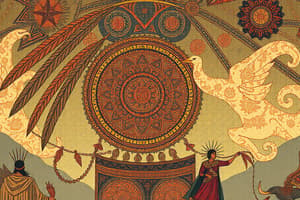Podcast
Questions and Answers
What is a significant impact of European settlers on Native American societies?
What is a significant impact of European settlers on Native American societies?
- Introduction of new agricultural methods
- Displacement and broken treaties (correct)
- Development of complex trade systems
- Integration of European cultural practices
Which of the following best describes the governance structure of many Native American tribes?
Which of the following best describes the governance structure of many Native American tribes?
- Oligarchy composed of wealthy elders
- Democratic system with regular elections
- Centralized monarchy led by a king
- Governance by councils or chiefs (correct)
What is a key aspect of the religious beliefs of many Native American tribes?
What is a key aspect of the religious beliefs of many Native American tribes?
- Adherence to a single holy text
- Focus on personal salvation through faith
- Ceremonies and rituals centered on nature (correct)
- Emphasis on monetary donations for spiritual growth
How many federally recognized tribes are estimated to exist in the United States?
How many federally recognized tribes are estimated to exist in the United States?
In what way do Native American art and crafts often reflect their culture?
In what way do Native American art and crafts often reflect their culture?
What major event is associated with the forced relocation of Native Americans in the 19th century?
What major event is associated with the forced relocation of Native Americans in the 19th century?
Which of the following issues is still prevalent among Native American communities today?
Which of the following issues is still prevalent among Native American communities today?
Which cultural region is NOT mentioned as a major area where Native American tribes are found?
Which cultural region is NOT mentioned as a major area where Native American tribes are found?
Flashcards are hidden until you start studying
Study Notes
Overview of American Indians
- Indigenous peoples of the Americas, often referred to as Native Americans or American Indians.
- Diverse cultures, languages, and traditions across various tribes and nations.
Historical Context
- Estimated to have inhabited North America for over 15,000 years.
- Arrival of European settlers in the 15th century led to significant changes and challenges.
Tribal Diversity
- Over 500 federally recognized tribes in the United States.
- Major cultural regions:
- Eastern Woodlands
- Plains
- Southwest
- Northwest Coast
- Arctic
Social Structure
- Tribes often governed by councils or chiefs.
- Societies typically organized around kinship and clan systems.
Religion and Spirituality
- Belief systems often centered on nature and the spiritual world.
- Practices include ceremonies, rituals, and storytelling.
Language
- Hundreds of distinct languages; many tribes have their own languages.
- Language revitalization efforts are ongoing to preserve endangered languages.
Art and Culture
- Rich traditions in music, dance, pottery, weaving, and painting.
- Craftsmanship often reflects cultural significance and history.
Historical Challenges
- Colonization led to displacement, broken treaties, and cultural assimilation efforts.
- Significant events include the Trail of Tears and the Indian Wars.
Modern Issues
- Ongoing struggles for sovereignty, land rights, and cultural preservation.
- Economic challenges, health disparities, and access to education.
Contributions
- Significant contributions to American culture, including agriculture (e.g., corn, beans, squash).
- Involvement in contemporary politics and environmental advocacy.
Legal Status
- Tribes recognized as sovereign nations; have their own governments and laws.
- Issues related to gaming, resource management, and federal policies.
Current Trends
- Resurgence of cultural identity and pride among Native communities.
- Collaborations for social justice, economic development, and environmental stewardship.
Overview of American Indians
- Indigenous peoples known as Native Americans or American Indians, embodying diverse cultures across numerous tribes.
- Rich tapestry of traditions and languages held within different tribal nations.
Historical Context
- More than 15,000 years of habitation in North America predates European arrival in the 15th century.
- European colonization triggered profound societal shifts and adversities for Indigenous populations.
Tribal Diversity
- Over 500 federally recognized tribes exist across the United States, highlighting extensive tribal variation.
- Major cultural regions encompass:
- Eastern Woodlands
- Plains
- Southwest
- Northwest Coast
- Arctic
Social Structure
- Governance typically involves councils or chiefs, reflecting communal decision-making.
- Societies often structured around kinship ties and clan systems, emphasizing familial bonds.
Religion and Spirituality
- Belief systems predominantly centered on nature and spirituality, showcasing a deep connection to the environment.
- Cultural practices include ceremonies, rituals, and storytelling to convey traditions and values.
Language
- Hundreds of distinct languages, with each tribe often maintaining its own linguistic heritage.
- Efforts to revitalize endangered languages are in progress, aiming to preserve cultural identity.
Art and Culture
- Rich traditions in various art forms, including music, dance, pottery, weaving, and painting.
- Craftsmanship serves as a reflection of cultural significance and historical narratives.
Historical Challenges
- Colonization resulted in the displacement of Native populations, broken treaties, and enforced cultural assimilation.
- Key historical events include the Trail of Tears and various conflicts known as the Indian Wars.
Modern Issues
- Ongoing challenges related to tribal sovereignty, land rights, and the preservation of cultural heritage.
- Economic hardships, health disparities, and educational access remain pressing concerns for Indigenous communities.
Contributions
- Native Americans have significantly influenced American culture, particularly in agriculture with crops like corn, beans, and squash.
- Active participation in contemporary political realms and environmental advocacy illustrates ongoing influence.
Legal Status
- Tribes are recognized as sovereign nations, possessing their own governance and regulatory systems.
- Ongoing legal matters involve gaming operations, resource management, and federal policy implications.
Current Trends
- Resurgence in cultural identity and pride among Native communities signals a revitalization of traditions.
- Collaborations prioritize social justice, economic development, and environmental stewardship initiatives.
Studying That Suits You
Use AI to generate personalized quizzes and flashcards to suit your learning preferences.




